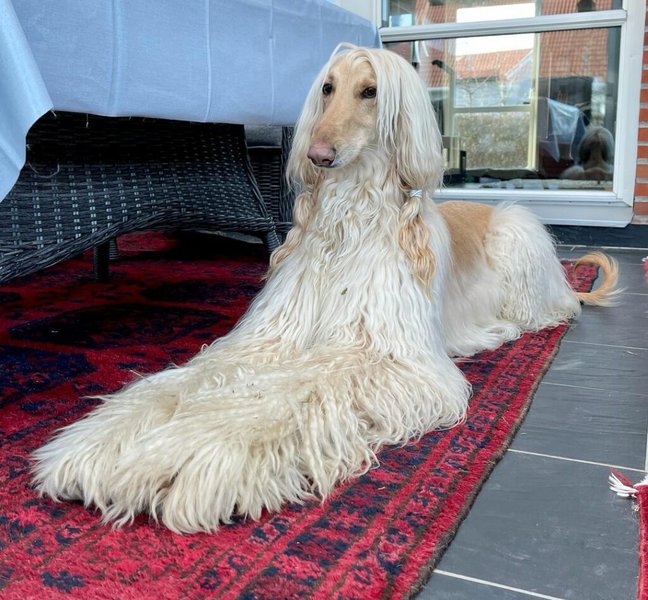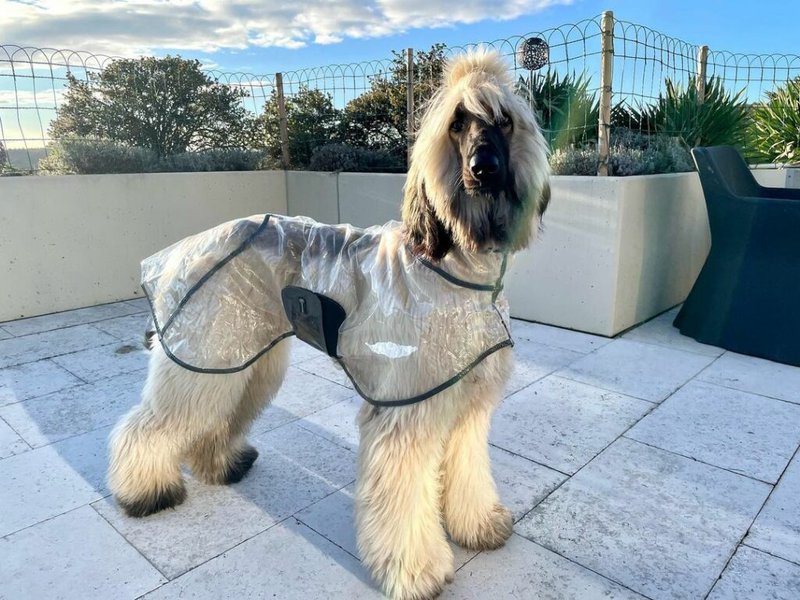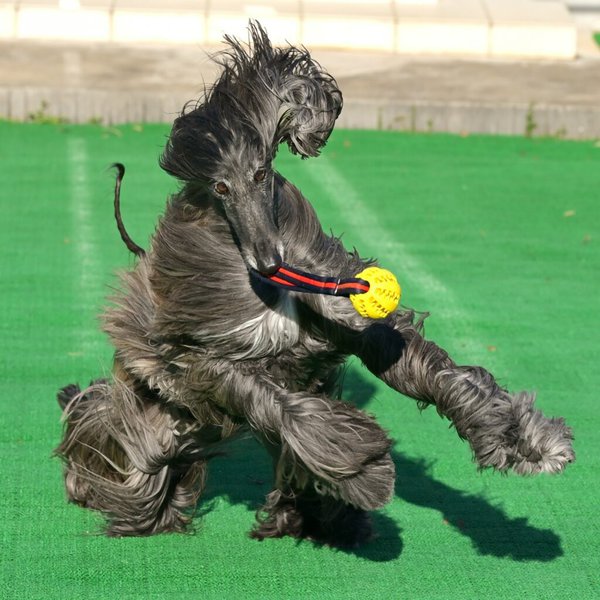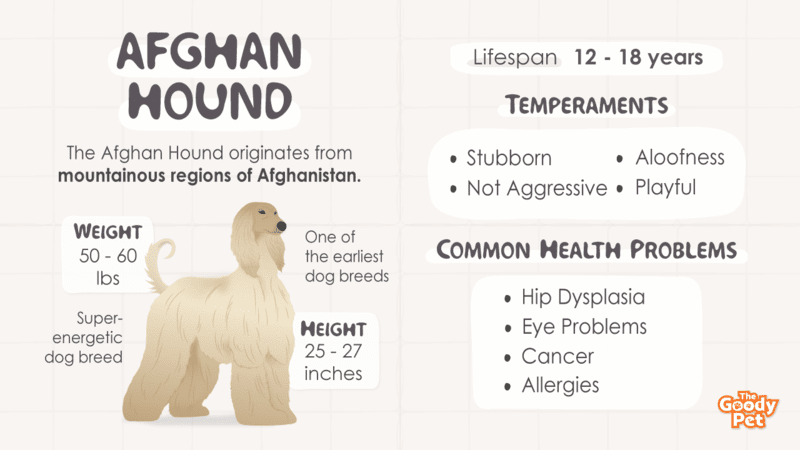The Afghan Hound has a few striking characteristics. For instance, the tail of the Afghan Hound curls upward into a distinctive ring. While many dog breeds have curly tails, the Afghan Hound’s tail becomes less furry near its end. If its long, silky coat is trimmed, you can always identify this breed by its tail.
Also known as the Barakzai Hound, the Afghan Hound originates from the cold, mountainous regions of Afghanistan. This dog breed has a distinctive long face and muzzle, creating a unique appearance. As it matures, a thick, long, silky coat develops and covers most of its body. If left untrimmed, the fur on the head can grow so long that it will look like a wig.
In this article, we explain everything you need to know about this special dog breed. Although they’re unique in appearance, they, too, have issues common to all dog breeds. This includes health concerns and temperament issues that are important to be aware of. But before we review those, let’s start with their typical size.
How Big Do Afghan Hounds Get?

The Afghan Hound is a medium to large dog breed. A fully grown male Afghan Hound is about 27 inches tall (measured from the ground to shoulder). Afghan Hounds weigh about 60 lbs. Female adults are about 2 inches shorter than males and 10 lbs lighter.
Unusual Look
Earlier, it had been mentioned that the Afghan Hound’s long, thick, silky coat covered much of its body. But there are parts that are not covered by this thick coat. Those parts include a long, narrow stretch from the middle to the lower back. Also, the face and the end of its tail do not have as much hair as the rest of the body. Its dignified gait matches its regal appearance.
Coat Color
Dogs of this breed come in a variety of colors. These include black, blue, dark brown, reddish-brown, cream, silver, and white. Some have a combination of two or more such colors. Light-colored dogs may have a wide variety of black markings. Most of these light-colored pooches also have noticeably dark facial masks.
Similarity To Other Sight Hounds
As a sight hound, the Afghan Hound is a deep-chested dog. This will mean that the chest drops low enough to reach its elbows.
The breed also has very low body fat. This is another characteristic of sight hound breeds. But you may not notice the skinny stature of an Afghan Hound since it is covered by a thick coat. But if the fur were to be trimmed down, you would immediately notice its lean physique.
It is also important to note the similarities between this breed and the Saluki (also a sight hound). Without the abundant fur, Afghan Hounds look much like the Saluki breed. In fact, DNA research proves the Afghan Hound is closely related to the Saluki.
Origin Of The Afghan Hound
According to DNA researchers, the Afghan Hound is one of the earliest dog breeds and dates back thousands of years. As mentioned, this dog breed originates from the cold, mountainous regions of Afghanistan. Its long, thick coat appears to be an adaptation that has helped the breed survive the harsh wintry conditions.
How Long Do Afghan Hounds Live?

The Afghan Hound has an average lifespan of about 12 years. But some live up to 18 years.
Common Health Issues
The common health issues Afghan Hounds can suffer from include cancer, allergies, and hip dysplasia. Large dog breeds are more susceptible to hip dysplasia, a deformity in the growth of the ball and the socket in the hip region, causing misalignment during a dog’s movement that can further lead to lameness. Do opt for routine checks with your family veterinarian to get it treated before the problem gets worse.
Afghan Hounds can also suffer from bloat (gastric dilatation volvulus). Fortunately, this ailment (bloat), which is common with sight hounds and other deep-chested breeds, rarely affects them. But when it does, it can be life-threatening.
Afghan Hounds can also develop eye problems as they age. These eye issues include medial canthal pocket syndrome and generalized progressive retinal atrophy (GPRA). Other commonly reported eye ailments are cataracts and corneal dystrophy.
Sensitivity To Anesthesia
Afghan Hounds are very sensitive to anesthesia. This is due to their low body fat, a common characteristic of sight hounds. Therefore, only veterinarians who are experienced with sight hounds should handle surgical procedures on Afghan Hounds.
How To Take Care Of Your Afghan Hound?
Exercise Routine
To ensure your Afghan Hound remains as healthy as possible, regularly take this pooch on long runs. Afghan Hounds love to run (like all sight hounds). If they are unable to exercise, they are miserable. This super-energetic breed typically needs about two hours of exercise daily. You should bear this in mind when planning a routine for your Afghan Hound.
If possible, you should make room at home for your Afghan Hound to play and run around. The fence around the play area should be high since the Afghan Hound is capable of jumping over low fences.
Also, leash your Afghan Hound when out on walks or runs. Dogs of this breed have a habit of chasing after any small animal they see. So, walking an Afghan Hound unleashed is a bad idea.
High-Quality Diet

Like most dog breeds, Afghan Hounds should be fed protein-rich food. It is recommended that you feed your Afghan Hound one cup of dry dog food twice a day. Veterinarians also recommend multivitamin blends that will greatly benefit the health of your Afghan Hound.
For this purpose, try out Pet Plate’s Barkin’ Beef and Chompin’ Chicken recipes for its freshly made meals packaged individually. Your Barakzai Hound will surely love these!
Use Dental Water Additives
Vets recommend the regular use of dental water additives for Afghan Hounds. Add these to your Afghan Hound’s drinking water every day. This helps prevent bad breath and plaque formation, thereby maintaining your pooch’s oral health.
Are Afghan Hounds Aggressive? Temperaments Of Afghan Hounds
Afghan Hounds are not widely known to be an aggressive dog breed nor have biting tendencies. They notably have an aloof, laid-back character and a very strong preference for their own space. Next, one may wonder how well they fare with kids while planning to have one in a family.
Is An Afghan Hound A Good Family Dog?
Afghan Hounds are not particularly good with kids. This breed could bite in self-defense if subjected to the typical pranks children play on pets or simply due to rough handling.
Also, the Afghan Hound is noted for aloofness. While dogs of this breed can be playful and need plenty of space to run around, they are also fond of keeping to themselves. All of this makes the Afghan Hound somewhat unsuitable as a family dog.
Are Afghan Hounds Good As Guard Dogs?
Yes, though Afghan Hounds may function as guard dogs, they aren’t too good at it. Their exceptional alertness counts in their favor, and they bark if they see an intruder or anything suspicious. But they lack the aggressiveness you would expect of a typical guard dog.
Trainability

Another noteworthy attribute is that the Afghan Hound is one of the most difficult dog breeds to train. They generally perform poorly on obedience tests. However, this poor performance has very little to do with low intelligence.
Instead, this happens because, unlike most breeds, the Barakzai Hound doesn’t feel the need to impress its owner or anyone else. Moreover, this dog breed is notably stubborn, and it can take a lot of patience and effort to train one properly.
The Afghan Hound’s Hunting Instinct
Afghan Hounds are also not tolerant of smaller pets. They can’t seem to resist the temptation to run after smaller animals because they were originally bred to hunt. This hunting instinct makes it impossible to take them on a walk without a leash.
If you do so, they will likely run after the first small animal they come across. You have been warned! However, if you raise an Afghan Hound with a smaller pet from birth with a smaller pet, your doggie will learn to accommodate it.
Do Afghan Hounds Shed? Grooming Tips For Afghan Hounds
Afghan Hounds shed very little. Unlike many other dog breeds that have both a topcoat and an undercoat, this dog breed has a single coat. This is partly responsible for their low shedding profile.
Is The Afghan Hound Hypoallergenic?
Yes, the Afghan Hound is hypoallergenic. If any member of your household is allergy-prone, you may be concerned about the Barakzai Hound’s abundant hair. But you have nothing to fear. This breed doesn’t drool much and hardly sheds.
Bathing And Grooming
Afghan Hounds require regular bathing. Bathing and brushing prevent fur from tangling or harboring ticks and other parasites.
Bathing and grooming an Afghan Hound can be quite a chore considering its coat’s thickness. Dogs of this breed should be bathed at least once a week using a good pet shampoo like Paws & Pals 6-In-1 Oatmeal Dog Shampoo. It is also helpful to apply a hair conditioner immediately after bathing while the fur is still wet. Dry the coat using a hairdryer thereafter.
Brushing
An Afghan Hound’s fur requires regular brushing. But it is recommended you do this only after bathing your dog. Remove excess fur with a hand-held de-shedding tool like the FURminator.
In addition to a de-shedding tool, you will need dog nail clippers for nail trimming. Dog toothbrushes are also available for cleaning your dog’s teeth. You may use a regular toothbrush for this but do not use regular toothpaste as it could harm the dog.
Related Questions
How Much Does An Afghan Hound Puppy Cost? An Afghan Hound puppy typically costs between $400 and $2,500, depending on the seller. Puppies from backyard breeders are the cheapest, with offers normally costing less than $1,000. But there are certain risks and ethical controversies arising when dealing with these breeders. In most cases, they don’t take care to weed out dogs with genetic conditions. And these conditions may have been passed on to your puppy, leading to higher vet bills later. On the other hand, puppies from professional dog breeders typically cost $1,000 or more. Professional breeders breed from a healthy lineage and vaccinate puppies. So, their puppies are generally healthier than those from amateur breeders. And though they cost more, you could save a lot of money overall.
Are Afghan Hounds Related to Greyhounds? Both Afghan Hounds and Greyhounds belong to the sight hound family of dogs. Sight hounds are a group of dog breeds that were bred for hunting. They rely primarily on great eyesight (for spotting prey) and incredible speed (for chasing prey down). Sight hounds also share similar physiological characteristics. These include a deep chest, narrow waist, long legs, and low body fat. Both Afghan Hounds and Greyhounds have these characteristics, while the former is more closely related to the Saluki.
Why Is The Afghan Hound The Dumbest Dog? The Afghan Hound is thought to be rather dumb due to poor performance on obedience tests. But as mentioned earlier, this has little to do with a lack of intelligence. Dog breeds that perform well on obedience tests are usually eager to please their owner or trainer. But the Afghan Hound hardly ever feels the need to impress anyone. Its aloofness and independence make it very difficult to train. In summary, the Afghan Hound performs poorly on these tests, not because they’re unintelligent, but because they don’t feel motivated to comply.





